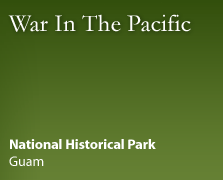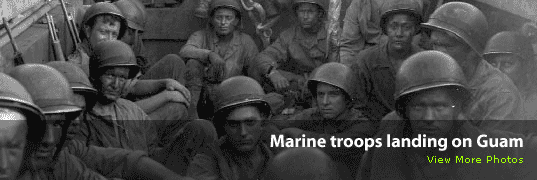|
|
War in the Pacific National Historical Park
|
|
| |
| War in the Pacific National Historical Park is located on the tropical island of Guam, approximately 13 degrees north of the equator and about 3,300 miles southwest of Hawaii. On Guam there is an embracing "hafa adai" attitude that welcomes visitors and makes the island a friendly travel destination and a unique place to live in the United States.

While Guam is only 212 square miles, the island is rich in history. Only hours after Pearl Harbor was attacked, the Japanese began aerial bombings on Guam. After two days of strafing, the Japanese came ashore and hours later the naval governor surrendered the American territory. The island remained under Japanese control for 31 months until July 21, 1944 when the United States returned and liberated the island. Many lives were lost and the suffering was great for all those involved in the battles on Guam and throughout the Pacific theater. In order to remember the United State's and Guam's involvement in World War II, War in the Pacific was established in 1978 to commemorate the bravery and sacrifice of those participating in the campaigns of the Pacific Theater of World War II and to conserve and interpret outstanding natural, scenic, and historic values and objects of the island of Guam.
While the park is most noted for its historical resources, the warm climate, sandy beaches, and turquoise waters beckon visitors and residents to discover and rediscover the island's history, environment, and recreational opportunities.
 |
|
DID YOU KNOW
 |
War in the Pacific NHP has more water acres (1002) than land acres (926)? |
| |
|
 |
The Fonte Plateau Unit was the site of a former Japanese naval communications center on Guam during World War II. |
| |
|
 |
The three Japanese coastal defense guns located at the Piti unit were never fired? |
| |
|
 |
That more than 50 years ago, by forced labor, the Chamorros built many of the Japanese fortification and defense structures that can be seen throughout the park and island? |
| |
|
 |
Within the seven park units there are coral reefs, limestone forests, wetlands, a mahogany forest, and tropical savannah ecosystems? |
| |
|
 |
War in the Pacific has one of the highest levels of species diversification within the park service and has one of the most diverse coral reefs? |
| |
|
 |
During the Japanese occupation the area now known as Asan Beach Unit was a rice paddy? |

DON'T MISS ATTRACTIONS

NATIONAL PARK SERVICE PRIORITIES
As a result of the devastating effects of Supertyphoon Pongsona, War in the Pacific has been without a museum, contact facility, or administrative offices since December 2002. Management objectives for the upcoming years are to develop a new contact facility and museum for park visitors, establish new administrative offices for park staff, and identify a curatorial facility.
The interpretation division is increasing its interpretive tours and outreach programs to schools, and is active in local and national events such as Earth Day and National Public Lands Day. The Cultural Resource Division will conduct a 200 acre archeology survey within the park, and will continue its commitment to maintaining and rehabilitating existing cultural resources--such as its monuments and historical structures. The park will also complete its first Administrative History in the upcoming year. The Natural Resources division is actively conducting studies to document sedimentation on the island's coral reefs and documenting the effects of wildfire on tropical savannah grasslands, so the park can establish best management practices for reducing erosion. As participants in a nation-wide coral reef monitoring program, the park is dedicated to long-term monitoring of Guam's coral reefs, and is committed to completing comprehensive inventories of the park's flora and fauna.

FOR MORE INFORMATION
While the Dec. 8, 2002 Supertyphoon Pongsona may have destroyed the War in the Pacific's museum, visitor center and administrative offices, it hasn't stymied the park's enthusiasm or eagerness to share its resources and knowledge with the public. During the rebuilding period, they are using their creativity to fulfill their commitment to the community.
Supt. Eric Brunnemann accepted an invitation for the NPS to participate in "Career Day" at Andersen Middle School in Yigo, Guam. In efforts to show the students the natural, historical and cultural resources that abound on Guam and in the park, Eric brought with him Park Ranger Ali Spittler, Park Ecologist Dwayne Minton and Museum Curator Tammy Duchesne. Each brought resources, samples, items or artifacts that would help explain the island's cultural prehistory, the natural resources and the events of WWII.
Students were rotated from one special interest table to another so they could see how the War in the Pacific NHP works towards its mission to "commemorate the bravery and sacrifice of those participating in the Pacific Theater of World War II" and to conserve and interpret the "outstanding natural, scenic and historical objects on the island of Guam for the benefit and enjoyment of present and future generations." Students enjoyed the diverse presentation and there was clearly something that appealed to everyone.
This was the first occurrence of the park taking staff members and resources off-site since the typhoon damage and the park has done similar visits to other local schools. For more information about the park's recovery efforts visit www.nps.gov/wapa.
By Tammy Duchesne, museum curator |
Last Updated: 26-May-2004 |
|
|
|
|
|





